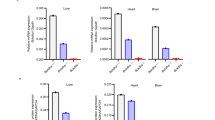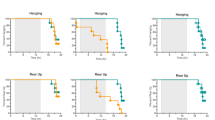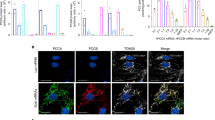Abstract
Urea cycle defects presenting in the neonatal period with hyperammonaemia are associated with high morbidity and mortality, and necessitate liver transplantation for long-term management. Gene therapy is therefore an attractive possibility, with vectors based on adeno-associated virus (rAAV) currently showing exciting promise in liver-targeted clinical trials in adults. Successful use of rAAV vectors in infants, however, is more challenging as episomal rAAV genomes will be lost from proliferating hepatocytes during liver growth, leaving stable transgene expression dependent on the subset of vector genomes that undergo genomic integration. To explore this challenge, we exploited the partially ornithine transcarbamylase (OTC)-deficient spfash mouse model and small hairpin RNA-mediated knockdown of residual endogenous OTC enzyme activity in adult mice that had received neonatal treatment with an OTC-encoding rAAV. This leaves mice reliant on vector-encoded OTC activity that has persisted from the newborn period. Despite stable transduction in approximately 8% of hepatocytes and residual vector-encoded OTC activity of up to 33% of wild-type, well above endogenous spfash levels (5–7%), mice were not protected from hyperammonaemia. These data show that the distribution of OTC activity within the liver is critical and that rAAV vector re-delivery after early neonatal treatment is likely to be necessary for stable control of hyperammonaemia into adulthood.
This is a preview of subscription content, access via your institution
Access options
Subscribe to this journal
Receive 12 print issues and online access
$259.00 per year
only $21.58 per issue
Buy this article
- Purchase on Springer Link
- Instant access to full article PDF
Prices may be subject to local taxes which are calculated during checkout




Similar content being viewed by others
References
Nakai H, Yant SR, Storm TA, Fuess S, Meuse L, Kay MA . Extrachromosomal recombinant adeno-associated virus vector genomes are primarily responsible for stable liver transduction in vivo. J Virol 2001; 75: 6969–6976.
Miao CH, Snyder RO, Schowalter DB, Patijn GA, Donahue B, Winther B et al. The kinetics of rAAV integration in the liver. Nat Genet 1998; 19: 13–15.
Dando JS, Aiuti A, Deola S, Ficara F, Bordignon C . Optimisation of retroviral supernatant production conditions for the genetic modification of human CD34+ cells. J Gene Med 2001; 3: 219–227.
Wang Z, Zhu T, Qiao C, Zhou L, Wang B, Zhang J et al. Adeno-associated virus serotype 8 efficiently delivers genes to muscle and heart. Nat Biotechnol 2005; 23: 321–328.
Cunningham SC, Dane AP, Spinoulas A, Alexander IE . Gene delivery to the juvenile mouse liver using AAV2/8 vectors. Mol Ther 2008; 16: 1081–1088.
Wang L, Wang H, Bell P, McMenamin D, Wilson JM . Hepatic gene transfer in neonatal mice by adeno-associated virus serotype 8 vector. Hum Gene Ther 2012; 23: 533–539.
Nakai H, Montini E, Fuess S, Storm TA, Grompe M, Kay MA . AAV serotype 2 vectors preferentially integrate into active genes in mice. Nat Genet 2003; 34: 297–302.
Cunningham SC, Spinoulas A, Carpenter KH, Wilcken B, Kuchel PW, Alexander IE . AAV2/8-mediated correction of OTC deficiency is robust in adult but not neonatal spfash mice. Mol Ther 2009; 17: 1340–1346.
Cunningham SC, Kok CY, Dane AP, Carpenter K, Kizana E, Kuchel PW et al. Induction and prevention of severe hyperammonemia in the spfash mouse model of ornithine transcarbamylase deficiency using shRNA and rAAV-mediated gene delivery. Mol Ther 2011; 19: 854–859.
Doolittle DP, Hulbert LL, Cordy C . A new allele of the sparse fur gene in the mouse. J Hered 1974; 65: 194–195.
Hu C, Busuttil RW, Lipshutz GS . RH10 provides superior transgene expression in mice when compared with natural AAV serotypes for neonatal gene therapy. J Gene Med 2010; 12: 766–778.
Jungermann K . Zonation of metabolism and gene expression in liver. Histochem Cell Biol 1995; 103: 81–91.
Bachmanov AA, Reed DR, Beauchamp GK, Tordoff MG . Food intake, water intake, and drinking spout side preference of 28 mouse strains. Behav Genet 2002; 32: 435–443.
Saphir O . Autopsy Diagnosis and Technique 4th edn. Hoeber-Harper: New York, 1958.
Wu Z, Asokan A, Samulski RJ . Adeno-associated virus serotypes: vector toolkit for human gene therapy. Mol Ther 2006; 14: 316–327.
Kok CY, Cunningham SC, Carpenter KH, Dane AP, Siew SM, Logan GJ et al. Adeno-associated virus-mediated rescue of neonatal lethality in argininosuccinate synthetase-deficient mice. Mol Ther 2013, e-pub ahead of print 2 July 2013; doi:10.1038/mt.2013.139.
Graham FL, Smiley J, Russell WC, Nairn R . Characteristics of a human cell line transformed by DNA from human adenovirus type 5. J Gen Virol 1977; 36: 59–74.
Gao GP, Alvira MR, Wang L, Calcedo R, Johnston J, Wilson JM . Novel adeno-associated viruses from rhesus monkeys as vectors for human gene therapy. Proc Natl Acad Sci USA 2002; 99: 11854–11859.
Lizee G, Aerts JL, Gonzales MI, Chinnasamy N, Morgan RA, Topalian SL . Real-time quantitative reverse transcriptase-polymerase chain reaction as a method for determining lentiviral vector titers and measuring transgene expression. Hum Gene Ther 2003; 14: 497–507.
Ye X, Robinson MB, Batshaw ML, Furth EE, Smith I, Wilson JM . Prolonged metabolic correction in adult ornithine transcarbamylase-deficient mice with adenoviral vectors. J Biol Chem 1996; 271: 3639–3646.
Mulligan RC . The basic science of gene therapy. Science 1993; 260: 926–932.
Acknowledgements
We thank Margot Latham (the Children’s Hospital at Westmead) for assistance in manuscript preparation. This work was supported by a grant (APP1008021) from the National Health and Medical Research Council of Australia.
Author information
Authors and Affiliations
Corresponding author
Ethics declarations
Competing interests
The authors declare no conflict of interest.
Rights and permissions
About this article
Cite this article
Cunningham, S., Kok, C., Spinoulas, A. et al. AAV-encoded OTC activity persisting to adulthood following delivery to newborn spfash mice is insufficient to prevent shRNA-induced hyperammonaemia. Gene Ther 20, 1184–1187 (2013). https://doi.org/10.1038/gt.2013.51
Received:
Revised:
Accepted:
Published:
Issue Date:
DOI: https://doi.org/10.1038/gt.2013.51
Keywords
This article is cited by
-
OTC intron 4 variations mediate pathogenic splicing patterns caused by the c.386G>A mutation in humans and spfash mice, and govern susceptibility to RNA-based therapies
Molecular Medicine (2021)
-
Delivery of glutamine synthetase gene by baculovirus vectors: a proof of concept for the treatment of acute hyperammonemia
Gene Therapy (2015)



